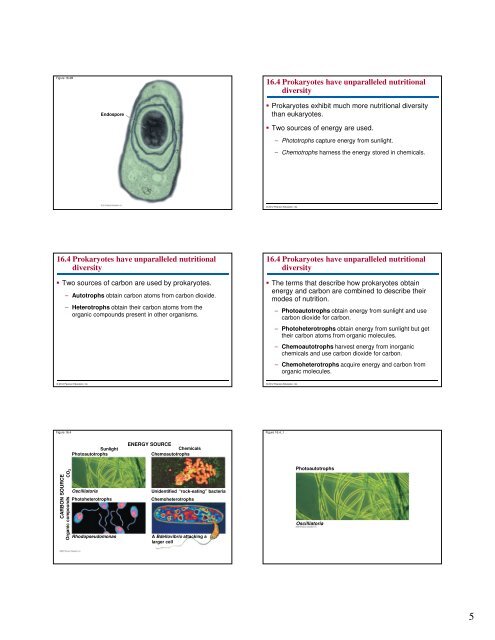Microbial Life: Prokaryotes and Protists - Renz Science
Microbial Life: Prokaryotes and Protists - Renz Science
Microbial Life: Prokaryotes and Protists - Renz Science
Create successful ePaper yourself
Turn your PDF publications into a flip-book with our unique Google optimized e-Paper software.
Figure 16.3B16.4 <strong>Prokaryotes</strong> have unparalleled nutritionaldiversityEndospore <strong>Prokaryotes</strong> exhibit much more nutritional diversitythan eukaryotes. Two sources of energy are used.– Phototrophs capture energy from sunlight.– Chemotrophs harness the energy stored in chemicals.© 2012 Pearson Education, Inc.16.4 <strong>Prokaryotes</strong> have unparalleled nutritionaldiversity Two sources of carbon are used by prokaryotes.– Autotrophs obtain carbon atoms from carbon dioxide.– Heterotrophs obtain their carbon atoms from theorganic compounds present in other organisms.16.4 <strong>Prokaryotes</strong> have unparalleled nutritionaldiversity The terms that describe how prokaryotes obtainenergy <strong>and</strong> carbon are combined to describe theirmodes of nutrition.– Photoautotrophs obtain energy from sunlight <strong>and</strong> usecarbon dioxide for carbon.– Photoheterotrophs obtain energy from sunlight but gettheir carbon atoms from organic molecules.– Chemoautotrophs harvest energy from inorganicchemicals <strong>and</strong> use carbon dioxide for carbon.– Chemoheterotrophs acquire energy <strong>and</strong> carbon fromorganic molecules.© 2012 Pearson Education, Inc.© 2012 Pearson Education, Inc.Figure 16.4Figure 16.4_1SunlightPhotoautotrophsENERGY SOURCEChemicalsChemoautotrophsCARBON SOURCEOrganic compounds CO 2OscilliatoriaPhotoheterotrophsRhodopseudomonasUnidentified “rock-eating” bacteriaChemoheterotrophsA Bdellovibrio attacking alarger cellPhotoautotrophsOscilliatoria5


